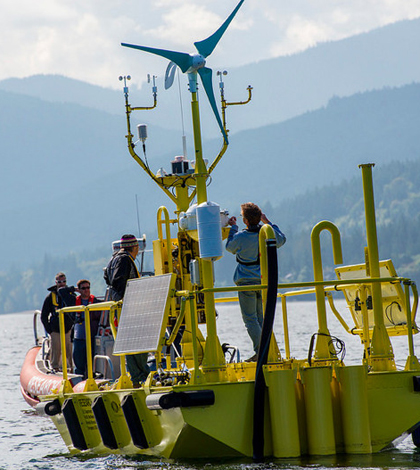Advanced buoys to assess U.S. offshore wind energy potential

Laboratory staff test one of the two new buoys in Sequim Bay, Washington, before their deployments to measure offshore wind (Credit: Pacific Northwest National Laboratory)
Two advanced data buoys off the United States’ Pacific and Atlantic coasts will begin collecting data on offshore winds this November. The Pacific Northwest National Laboratory scientists behind the project say the data will help assess the potential for offshore wind farms and cut costs for renewable energy.
Will Shaw, project lead and an earth systems analysis and modeling scientist at the laboratory, said the buoys are specially outfitted NOMAD buoys from AXYS Technologies that have been “used worldwide for decades by oceanographers.” Each of the buoys has a self-contained computer to record and keep track of its data, Shaw said.
The project’s ultimate goal is “to answer physics questions and drive down the costs of providing offshore energy,” Shaw said. If the project is successful, it could reduce uncertainty when predicting energy availability — a significant challenge when planning wind farms.
The buoys, which Shaw said took less than a year to prepare, will track wind speed with LiDAR. They will measure water temperature, conductivity, waves and currents, as well as meteorological variables such as air temperature, relative humidity and barometric pressure.
The buoys, worth a little over $2 million combined, will be stationed off Virginia Beach, Virginia, and near Coos Bay in Oregon. They will remain at their posts for a year before moving to new locations. Scientists will collect data by either visiting the buoys and transmitting data back to the lab using cell phones or by receiving data via satellite.
A recent study by ABB, an automation and power technology company, estimated that almost 17 million American homes could be powered on a little over 50 gigawatts of offshore wind energy.
“The Department of Energy is continuing to work to find ways to reduce the cost of energy,” Shaw said. The project “represents a significant investment and we’re certainly looking forward to putting the buoys to work.”





0 comments